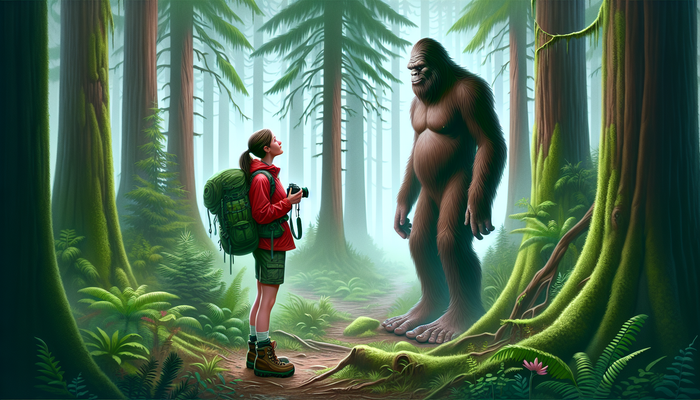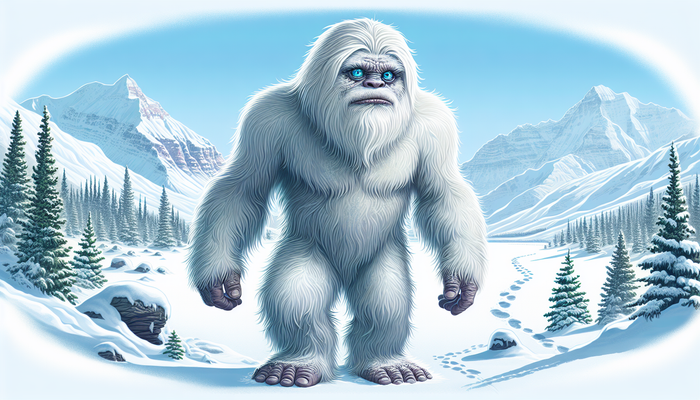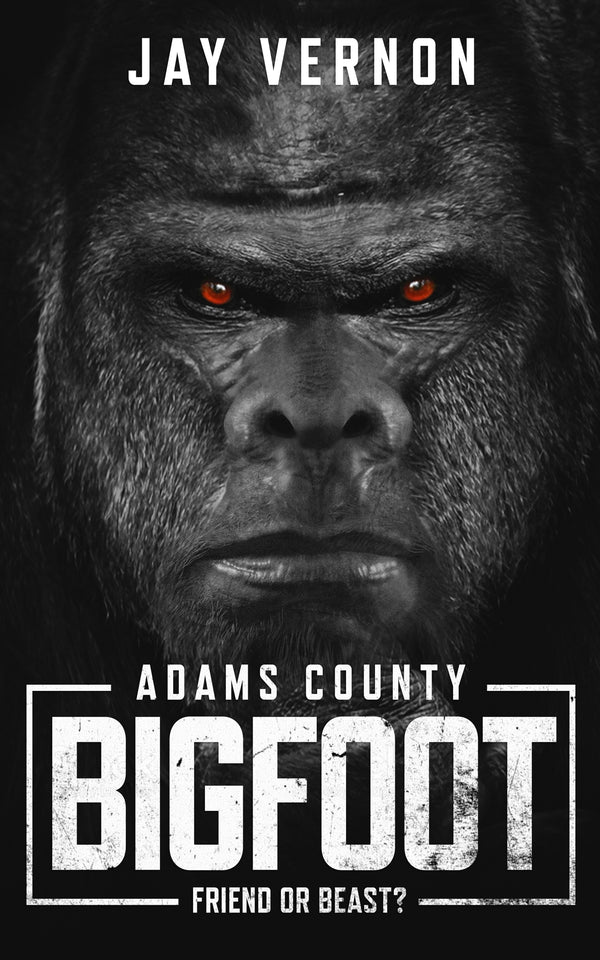South Carolina Bigfoot Sightings Map: A Cryptozoological Hotspot Revealed

By Oliver Bennett, Cryptozoologist
In the realm of cryptozoology, few creatures have captured the human imagination quite like Bigfoot, also known as Sasquatch. This elusive, ape-like being has been the subject of countless tales, investigations, and debates, with sightings reported across North America. However, one state has recently emerged as a surprising hotspot for Bigfoot activity: South Carolina. The 'south carolina bigfoot sightings map' serves as a fascinating window into this cryptozoological phenomenon, revealing a rich tapestry of encounters, mysteries, and unanswered questions.
As a researcher and writer with a deep fascination for the unexplained, I have long been intrigued by the Bigfoot enigma. My quest for knowledge has led me to explore the historical accounts, indigenous narratives, and contemporary sightings that shape our understanding of this legendary creature. In this article, I invite you to join me on a journey through the 'south carolina bigfoot sightings map', as we delve into the surprising emergence of the Palmetto State as a Bigfoot haven and the implications for our understanding of this enduring mystery.
The Bigfoot Field Researchers Organization (BFRO) and South Carolina Sightings
At the forefront of Bigfoot research stands the Bigfoot Field Researchers Organization (BFRO), the oldest and largest organization dedicated to investigating and documenting Sasquatch sightings. Founded in 1995, the BFRO has amassed an extensive database of reports from across North America, providing a valuable resource for researchers and enthusiasts alike.
According to BFRO data, South Carolina has been the site of at least 57 reported Bigfoot sightings since 1964, with the most recent incidents occurring in 2022. These sightings span the state, from the coastal Lowcountry to the rugged Upstate region, suggesting that Bigfoot activity is not confined to a single area but rather distributed across South Carolina's diverse landscapes.
The BFRO's meticulous documentation and investigation of these sightings lend credibility to the notion that something extraordinary may be afoot in the Palmetto State. As we explore the 'south carolina bigfoot sightings map', it becomes clear that South Carolina's emergence as a Bigfoot hotspot is not a mere fluke but rather a pattern that demands closer examination.
Top Counties for Bigfoot Sightings in South Carolina
A closer look at the 'south carolina bigfoot sightings map' reveals several counties that stand out as epicenters of Bigfoot activity. Leading the pack is Lee County, located in the heart of the state. This unassuming county has been the site of eight reported Bigfoot sightings, more than any other county in South Carolina. The dense forests and swampy terrain of Lee County provide an ideal habitat for a creature seeking to remain hidden from human eyes.
Not far behind is Oconee County, nestled in the Upstate region along the border with Georgia. With four documented Bigfoot sightings, Oconee County has emerged as a hotspot within a hotspot, drawing the attention of researchers and enthusiasts alike. The county's rugged, mountainous landscape and vast tracts of undeveloped land make it a prime candidate for Sasquatch activity.
Orangeburg County, situated in the central part of the state, also boasts four reported Bigfoot sightings. The county's mix of agricultural land, dense forests, and river systems create a diverse ecosystem that could potentially support a creature like Bigfoot.
Berkeley County, located in the Lowcountry region, has likewise been the site of four Bigfoot encounters. The county's proximity to the Francis Marion National Forest, with its expansive wetlands and pine forests, provides ample cover for a large, elusive creature.
Finally, Horry County, home to the popular tourist destination of Myrtle Beach, has three reported Bigfoot sightings to its name. While the idea of Sasquatch sunbathing on the Grand Strand may seem far-fetched, the county's inland areas, with their sprawling woodlands and swamps, could conceivably harbor a Bigfoot population.
As we examine these hotspots on the 'south carolina bigfoot sightings map', a pattern emerges: Bigfoot seems to favor areas with dense forests, ample water sources, and minimal human development. These conditions, found in abundance across South Carolina, may explain why the state has become such a prominent location for Sasquatch sightings.
Notable Bigfoot Sightings in South Carolina
Among the many Bigfoot sightings documented on the 'south carolina bigfoot sightings map', a few stand out for their level of detail, credibility, and potential significance. One such incident occurred in August 2022 at Hunting Island State Park in Beaufort County, along the state's southern coast.
According to the BFRO report, three retired professionals were leaving the park's lighthouse area around noon when they spotted a creature, estimated to be between 5 and 6 feet tall, walking upright and quickly disappearing into the dense vegetation along the exit road. The witnesses provided a detailed description of the creature, noting its dark brown, splotchy black hair, human-like knee joint, and legs approximately 3 feet in length.
What sets this sighting apart is the BFRO's classification of it as a 'Class A' incident, meaning that the circumstances were such that misidentification of other animals could be confidently ruled out. The clear, daylight observation by multiple credible witnesses, combined with the detailed description of the creature, make this a compelling case for further investigation.
Another notable sighting occurred in 2008, when a resident of Bluffton, near the Georgia border, reported a Bigfoot encounter to the BFRO. While details are scarce, the mere fact that a sighting was reported in this coastal community suggests that Bigfoot activity may extend beyond the state's inland forests.
Perhaps the most historically significant Bigfoot sighting in South Carolina occurred in the fall of 1964 at Fort Jackson, a U.S. Army training facility in Richland County. According to the BFRO report, a soldier on a solo training mission found himself alone in the woods at night when he encountered a mysterious, bipedal creature. The soldier described the creature as making a "backwards in a sort of growl" sound before fleeing into the brush.
This early sighting, occurring just a few years after the famous Patterson-Gimlin film brought Bigfoot into the national spotlight, suggests that South Carolina's history with the creature may be longer and richer than previously thought. As we explore the 'south carolina bigfoot sightings map', it becomes clear that these notable sightings are just the tip of the iceberg, hinting at a vast, untold story of Sasquatch activity in the Palmetto State.
The Upstate Region: A Bigfoot Haven
While Bigfoot sightings have been reported across South Carolina, the Upstate region has emerged as a particular haven for Sasquatch activity. This rugged, mountainous area, bordered by North Carolina and Georgia, is home to vast tracts of undeveloped land, dense forests, and sparkling rivers and streams - an ideal habitat for a creature seeking to remain hidden from human eyes.
At the heart of the Upstate's Bigfoot activity is Uwharrie National Forest, located in Montgomery County. This sprawling wilderness, covering over 50,000 acres, has been the site of an astonishing 15 documented Bigfoot encounters, more than any other single location in South Carolina.
The Uwharrie National Forest's rugged terrain, characterized by steep hills, deep ravines, and thick undergrowth, provides ample cover for a large, elusive creature like Bigfoot. The forest's abundant water sources, including the Uwharrie, Yadkin, and Pee Dee rivers, as well as numerous streams and creeks, ensure a steady supply of drinking water and potential food sources for a Sasquatch population.
Other Upstate counties, such as Oconee, Pickens, and Greenville, have also reported Bigfoot sightings, albeit in smaller numbers than Montgomery County. These counties share similar geographical features - rugged terrain, dense forests, and ample water sources - that make them attractive to a creature like Bigfoot.
As we examine the Upstate region on the 'south carolina bigfoot sightings map', it becomes clear that this area is a cryptozoological treasure trove, offering a wealth of opportunities for Bigfoot research and investigation. The concentration of sightings in this region suggests that the Upstate may be home to a resident Sasquatch population, or at the very least, a frequent destination for these elusive creatures.
Diversity of Bigfoot-Related Phenomena in South Carolina
The 'south carolina bigfoot sightings map' reveals not only the geographic distribution of Sasquatch encounters but also the surprising diversity of Bigfoot-related phenomena in the state. While classic sightings of large, hairy, bipedal creatures dominate the reports, South Carolina is also home to a range of other cryptozoological oddities that may be related to the Bigfoot mystery.
One of the most intriguing of these is the Lizard Man of Scape Ore Swamp, a reptilian cryptid that has been sighted in Lee County since the late 1980s. Described as a tall, bipedal creature with scaly, green skin and glowing red eyes, the Lizard Man has become a local legend, attracting curiosity seekers and investigators from around the world.
While the Lizard Man may seem far removed from the classic Bigfoot archetype, some researchers have suggested that the two creatures may be related, perhaps representing different subspecies or evolutionary offshoots of a common ancestor. The presence of both Bigfoot and Lizard Man sightings in Lee County, as documented on the 'south carolina bigfoot sightings map', raises intriguing questions about the diversity of cryptids that may inhabit the state's swamps and forests.
In addition to visual sightings, the 'south carolina bigfoot sightings map' also includes reports of strange vocalizations and other auditory encounters. These range from the "backwards in a sort of growl" sound reported by the Fort Jackson soldier in 1964 to more recent reports of howls, screams, and other unidentifiable noises emanating from the wilderness.
Such auditory encounters suggest that Bigfoot may possess a complex system of communication, perhaps using a variety of vocalizations to convey different messages or emotions. The inclusion of these reports on the 'south carolina bigfoot sightings map' adds another layer of intrigue to the Bigfoot mystery, hinting at a creature with a rich and varied behavioral repertoire.
Finally, the map also documents instances of indirect evidence of Bigfoot activity, such as strange footprints, unexplained tree breaks, and even potential nesting sites. In York County, for example, a professional forester reported hearing "loud knocking sounds" and detecting a "strange smell" in an area where he also found evidence of a large animal's bedding site.
While such indirect evidence is not as compelling as a clear visual sighting, it nonetheless contributes to the overall picture of Bigfoot activity in South Carolina. By including these reports on the 'south carolina bigfoot sightings map', researchers can begin to build a more comprehensive understanding of Sasquatch behavior and ecology, piecing together the puzzle of this enduring cryptozoological mystery.
Witness Demographics and Credibility
One of the most striking aspects of the 'south carolina bigfoot sightings map' is the diversity of witnesses who have reported encounters with Sasquatch. Far from being the domain of wild-eyed fantasists or attention-seekers, the map includes reports from a wide range of individuals, from everyday citizens to trained professionals with specialized knowledge and expertise.
The August 2022 sighting at Hunting Island State Park, for example, involved three retired professionals who provided a detailed, consistent description of the creature they encountered. The fact that these witnesses were mature, educated individuals with no apparent motive for fabrication lends credibility to their account and elevates it above the realm of mere hearsay or speculation.
Similarly, the report from York County involving a professional forester who found evidence of a large animal's bedding site carries additional weight due to the witness's expertise in the field. As someone trained to observe and interpret the signs and traces left by wildlife, the forester's account of strange vocalizations, smells, and physical evidence cannot be easily dismissed as the product of misidentification or overactive imagination.
The inclusion of these credible witness accounts on the 'south carolina bigfoot sightings map' is significant for several reasons. First, it suggests that the Bigfoot phenomenon is not simply a matter of folklore or urban legend but rather a real, observable phenomenon that has been encountered by reliable, level-headed individuals.
Second, the diversity of witnesses represented on the map - from rural hunters to urban professionals - indicates that Bigfoot encounters are not limited to any particular demographic or social group. This widespread distribution of sightings across different segments of the population argues against the notion that Bigfoot is merely a cultural construct or a product of collective delusion.
Finally, the presence of credible witnesses on the 'south carolina bigfoot sightings map' underscores the need for serious, scientific investigation of the Bigfoot phenomenon. When reliable individuals with no history of hoaxing or attention-seeking come forward with detailed, consistent accounts of Sasquatch encounters, it becomes increasingly difficult to dismiss the possibility that there may be a real, undiscovered species lurking in the forests of South Carolina and beyond.
Challenging the Pacific Northwest as the Sole Bigfoot Territory
For decades, the Pacific Northwest has been synonymous with Bigfoot, with states like Washington, Oregon, and California dominating the popular imagination as the primary habitat of this elusive creature. However, the emergence of South Carolina as a Bigfoot hotspot, as documented on the 'south carolina bigfoot sightings map', challenges this long-held assumption and raises intriguing questions about the true distribution and adaptability of Sasquatch.
South Carolina's diverse ecosystems, ranging from the dense forests of the Upstate to the swampy lowlands of the Coastal Plain, provide a variety of potential habitats for a creature like Bigfoot. The state's mild climate, abundant water sources, and rich biodiversity could potentially support a resident Sasquatch population, or at the very least, offer attractive waypoints for a migratory species.
The concentration of Bigfoot sightings in certain regions of South Carolina, such as the Uwharrie National Forest and the Lowcountry swamps, suggests that these areas may possess specific ecological characteristics that are particularly appealing to Sasquatch. By studying these hotspots in detail, researchers may be able to identify the key habitat features that attract Bigfoot and use this knowledge to predict other potential areas of activity across the continent.
The implications of South Carolina's emergence as a Bigfoot territory extend beyond the state's borders and have the potential to reshape our understanding of this cryptozoological phenomenon. If Sasquatch can thrive in the diverse landscapes of the Palmetto State, it raises the possibility that the creature may be far more adaptable and widespread than previously thought.
This realization could lead to a reevaluation of Bigfoot sightings in other parts of the country, as well as a renewed interest in investigating areas that have been previously overlooked or dismissed as unlikely Sasquatch habitat. By challenging the Pacific Northwest's monopoly on Bigfoot activity, the 'south carolina bigfoot sightings map' opens up new avenues for research and exploration, inviting us to reconsider what we think we know about this enduring mystery.
From Bigfoot to UFOs: Hangar 1 Publishing Has You Covered!
Explore Untold Stories: Venture into the world of UFOs, cryptids, Bigfoot, and beyond. Every story is a journey into the extraordinary.
Immersive Book Technology: Experience real videos, sights, and sounds within our books. Its not just reading; its an adventure.



























